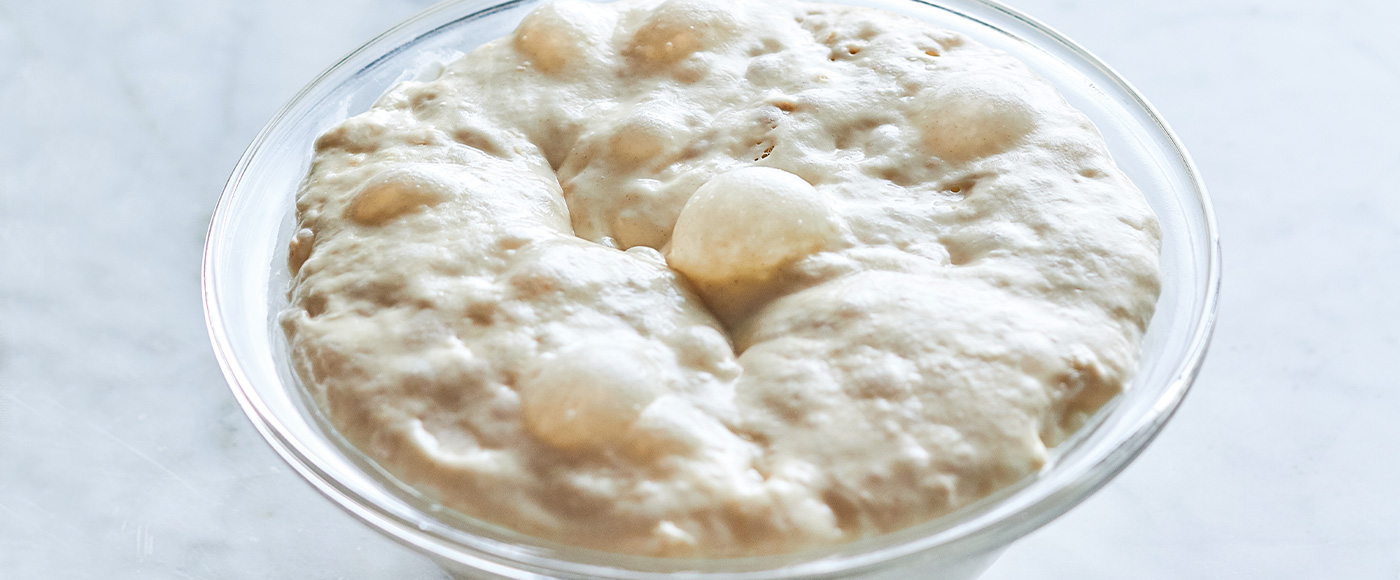Poolish is a type of pre-ferment commonly used in bread making. Originating from France, it is made from a mixture of equal parts flour and water, with a small amount of yeast. This simple starter enhances the flavor, texture, and shelf life of the final baked product. Poolish is especially popular in the production of artisan breads and pastries, offering a depth of flavor that is hard to achieve with direct dough methods.

Historical Significance of Poolish
The use of poolish dates back to the 19th century when French bakers sought ways to improve the quality of their bread. By incorporating this pre-ferment into their recipes, they were able to create loaves with a more complex flavor profile and better crumb structure. This technique quickly gained popularity and has since become a staple in traditional and modern baking.
Subscribe to our youtube channel Kitchenpedia for more delicious recipes and hit the like button if you enjoyed this video. Share it with your friends and Family.
Poolish Recipe
Ingredients
- 1 Cup Flour: All-purpose or bread flour is typically used.
- 1 Cup Water: Use lukewarm water for optimal yeast activity.
- 1/4 Tsp Yeast: Instant or active dry yeast can be used.
Instructions
- Mixing Flour and WaterIn a mixing bowl, combine the flour and water. Stir until the mixture is smooth and free of lumps.
- Adding YeastSprinkle the yeast over the mixture and stir until fully incorporated.
- Fermentation ProcessInitial MixingOnce the ingredients are combined, the mixture should have a batter-like consistency.
- Covering and RestingCover the bowl with plastic wrap or a kitchen towel to prevent the surface from drying out.
- Ideal Fermentation ConditionsPlace the bowl in a warm, draft-free area. The ideal temperature for fermentation is around 70-75°F (21-24°C).
- Fermentation TimeLet the poolish ferment for 12-16 hours, or until it has doubled in size and is bubbly on the surface. It should have a sweet, yeasty aroma.
- Using Poolish in BakingIncorporating Poolish into DoughMeasuring PoolishWhen your poolish is ready, measure the amount needed for your recipe. Typically, it replaces a portion of the flour and water in the final dough.
- Mixing with Additional IngredientsAdd the poolish to your dough mixture along with the remaining flour, water, salt, and any other ingredients your recipe requires. Mix until a cohesive dough forms.
- Benefits of Using PoolishFlavor EnhancementThe fermentation process develops natural sugars and acids, enhancing the flavor profile of your bread.Poolish contributes to a tender crumb and a crispy crust, making your baked goods more enjoyable.Bread made with poolish tends to stay fresher longer due to the natural preservatives formed during fermentation.Texture ImprovementExtended Shelf Life
Notes
Tips for Success
Choosing the Right Flour
Use high-quality bread flour with a protein content of around 12-14%. This ensures a strong gluten structure, which is crucial for the development of a good bread texture.
Fermentation Time
Allowing the poolish to ferment for at least 12 hours at room temperature (ideally around 70°F or 21°C) allows for optimal flavor development. You can adjust the fermentation time slightly based on your schedule and desired flavor intensity.
Temperature Control
Maintain a consistent room temperature for fermentation. Avoid placing the poolish in a drafty area or direct sunlight, as this can affect fermentation.
Frequently Asked Questions
Can I Make Poolish Ahead of Time?
Yes, you can prepare poolish up to 24 hours in advance. If you need to delay its use, refrigerate it after the initial fermentation period.
Why Is My Poolish Not Bubbling?
If your poolish is not bubbling, the yeast may be inactive, or the room temperature may be too low. Ensure the yeast is fresh and the mixture is kept in a warm environment.
Can I Use Different Types of Flour?
Yes, poolish is versatile and can be made with various flours, including whole wheat, rye, and gluten-free blends.
How Do I Adjust the Amount of Poolish in a Recipe?
Typically, poolish can replace up to 50% of the total dough weight in a recipe. Adjust the flour and water in the main dough to account for the poolish.
Click here to get more recipe ideas – Click Here
Conclusion:
Recap of the Recipe Steps
Making poolish is simple: mix equal parts flour and water with a small amount of yeast, and let it ferment for 12-16 hours. Incorporate it into your dough to enhance flavor and texture.
Encouragement to Experiment with Poolish
Experimenting with poolish can significantly improve your baking results. Try it in various recipes to discover the depth of flavor and texture it adds to your breads and pastries.
Final Thoughts on the Benefits of Poolish in Baking
Poolish is a powerful tool in the baker’s arsenal, offering a straightforward way to elevate homemade bread. Its ability to enhance flavor, improve texture, and extend shelf life makes it a valuable addition to any baking repertoire.

